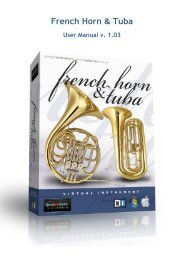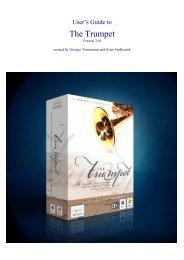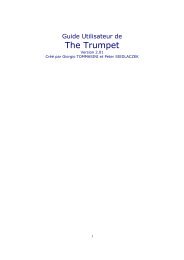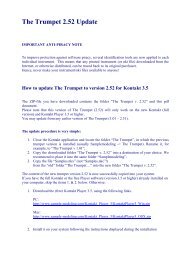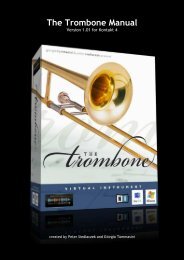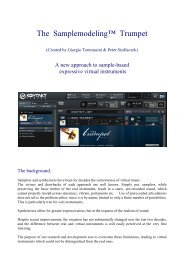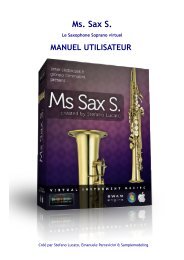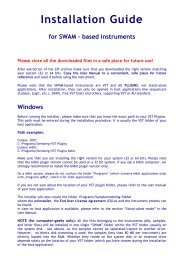The Trumpet - Sample Modeling
The Trumpet - Sample Modeling
The Trumpet - Sample Modeling
You also want an ePaper? Increase the reach of your titles
YUMPU automatically turns print PDFs into web optimized ePapers that Google loves.
Note-off keyswitches<br />
G1: Release pattern #1. This KS imparts a characteristic, rich release pattern to the<br />
next note- off.<br />
G#1: Release pattern #2. This KS imparts a very short release pattern to the next<br />
note-off. Very suitable for fast sequences.<br />
A1: Release pattern #3. This KS imparts a characteristic, vibrato-like ending release<br />
pattern to the next note-off.<br />
Tip: note-on, on-the-fly and note-off KS may be simultaneously activated for multiple<br />
modulations. For example, by holding down C#1 and pressing on-the-fly D#1 one can obtain<br />
a crescendo-decrescendo dynamic pattern. By simultaneously holding down C1 and A1, one<br />
can obtain a sforzato pattern with vibrato-like ending on each next staccato note.<br />
Note: CC26 also allow to modify the relative duration of each note-on and on-the-fly<br />
keyswitch. To perform this, you need to set the controller while holding down the keyswitch.<br />
Similarly, CC27 will allow to modify the relative duration of each release keyswitch. A<br />
message on the lower bar will report the new value. Please note that this new value will be<br />
stored, replacing the default. By pressing a keyswitch, the associated value will be displayed<br />
on CC26 and CC27 GUI knobs.<br />
Non-modulating keyswitches<br />
A#1: Wah-wah effect. This KS reproduces the wah-wah effect of the plunger. This<br />
effect is directly controlled by CC11. Two different plunger types (unused and used,<br />
presumably) are activated on the basis of the KS velocity. Activation/deactivation of the<br />
wah-wah actually takes place on the next detached note, to preserve the integrity of<br />
the phrase.<br />
B1: Short fall. This KS reproduces a typical short fall from the currently played note.<br />
This obviates the necessity of playing a very quick scale with staccato notes to get the<br />
same effect. <strong>The</strong> fall starts upon pressing the KS. <strong>The</strong> duration of the fall is determined<br />
by the KS velocity. <strong>The</strong> fall can be interrupted, before its natural end, by releasing the<br />
KS, or by playing a new note while the fall is still sounding.<br />
25




